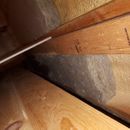Flash-and-batt: condensation particular
Good Day and Thank You in advance.
I have been reading as much as possible on the topic, but wanted a fresh take on my specific scenario.
That is-
Our house as far as I can tell has CC spray foam finished with Roxul (flash and batt).
I can not speak for any other area of the house other that the part that I have observed as attached. On the north wall of the house during temperatures of -10 C I noticed that when going to the unfinished and gravel floor basement that the bottom of the batts were dripping with condensation. I have since removed what I can at the bottom and added a fan to dry up the areas. There is a built in bookshelf that I can not access behind that creates a strange cavity air space as pictured. This space also channels to the second floor of the house and creates a chimney effect of air between the basement and the second floor (behind the bookshelf). I suspect that this is also problematic.
I understand that the likely cause of the condensation is that we do not have thick enough layer of CC. As far as I can tell we are about 1.25 -1.5 inches.
Knowing this, how should I fix?
I think that keeping the Roxul in place and then installing poly over the Roxul by stapling to the studs is likely a bad idea as I could trap any moisture in the future leading to bigger problems. Also this is not practical for me behind the bookshelf as I would have to tear it out. Please confirm my thought here about the poly.
What is best practice to fix this?
Improved mechanical systems for humidity/airflow?
More spray foam to increase the thickness therefore preventing the condensation?
Thanks Very much for the time.
Brian
GBA Detail Library
A collection of one thousand construction details organized by climate and house part












Replies
Is this 2x4 or 2x6 framing? Are the batts r23 or r15? And what climate zone are you in?
A smart vapor barrier like Membrain generally makes sense. It goes up just like poly sheet. Detailing it with a tape like 3m All Weather Flashing tape to be an air barrier is a good idea. You could also likely get with drywall and latex paint, but we will need details of the insulation depths and location.
Oh and for the bookshelf cavity, you will want to seal that opening with drywall or Membrain.
With a dirt basement and reasonably sealed upper part of the house, what is the relative humidity? A slab with a vapor barrier would make a lot of sense.
Good Day Matt,
Thanks for the reply and the suggestions so far. I was not aware or a product such as Membrain.
This is 2x6 framing where the CC is sprayed.
The batts are R14 as far as I can tell from an old package in the basement (I did not build).
Climate Zone 5 - Eastern Ontario near Kingston.
The relative Humidity in the basement I try to keep below 60 with a dehumidifier constantly running and emptying out every 2 days. There is poly on the ground and filled overtop with gravel.
The upper house is kept at about 40-60 %RH in the winter. The only mechanical system in the house is an exhaust fan out in the basement. The house has no HVAC or ducting. Wood heat on main floor and baseboards as backup. No HVR.
Hope these extra details help. Let me know if more pictures would be beneficial.
If you’re running a humidifier to maintain “40-60%” you should stop. 40% is generally about the HIGHEST you want the humidity level to be in your house in the winter, and oftentimes you really should be trying for a level lower than that.
Really high indoor humidity levels are probably the reason for all the condensation you’re seeing, especially if you’re running a humidifier to maintain those high levels.
Bill
Bill, they didn't mention a humidifier, just a dehumidifier in the basement. If there is a humidifier, definitely stop using it.
You definitely want to keep the RH away from 60%. The 30-40% is good.
I am surprised your house is as humid as it is. No bath fans? Small house with bunch of people? The basement seems like it may still be a significant source.
Hi Bill and Matt,
Thanks for the comments here.
The basement surely is a large source of humidity that I try to keep as low as possible by use of a dehumidifier. Perhaps I need to do a better job at this part...
The rest of the house as it is wood stove heated tends to dry out. For health reasons, my wife needs to keep a humidifier running upstairs in the bedroom to prevent that morning dry air headache, as we would end up at about 20% without the humidifier running in sleeping space. I have no reason to believe that this is significantly causing any problems to the basement scenario wall where I am getting condensation. Besides, as mentioned, my wife needs to keep the bedroom above 40% due to sinus concerns - so there is no way I can ditch this one.
Forgot to mention - yes we do have bath fans. One in each bathroom that are on timers and used 100% of the time when taking showers or baths.
Thanks for the considerations. Let me know if there are any other details I can provide to see if I can put the best fix in as possible.
Best,
Brian